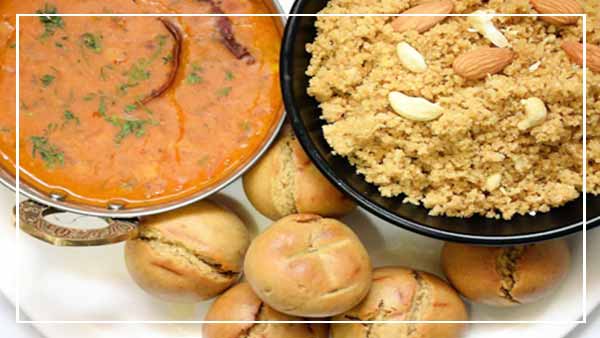Rajasthan Cuisine Both the warlike lifestyles of its inhabitants and the availability of ingredients in this arid region influenced Rajasthani cuisine. It was preferred food which could last for many days and could be eaten without heating. Water scarcity and fresh green vegetables all influenced cooking. It is also known for its Bikaneri bhujia, mirchi bada, and pyaaj kachori snacks. Other popular dishes include Malaidar special lassi (lassi) and Lashun ki chutney (hot garlic paste), Jodhpur’s Mawa lassi, Alwar ka mawa, Pushkar’s Malpauas and Bikaner’s rasgulla, Mewar’s “paniya”and” gheriya. Originating for the state’s Marwar region is the concept of Marwari Bhojnalaya, or vegetarian restaurants, Rajasthan Cuisine found today in many parts of India offering Marwari people’s vegetarian food. History also affects the diet as the Rajputs mainly preferred a non-vegetarian diet while the Brahmin, Jains, Maheshwari, Vaishnavas, and others preferred a vegetarian diet. So, the state has a myriad of both types of delicacies Rajasthan Cuisine.
1. Dal Bati Churma
Dal Bati Churma It is one of Rajasthani’s signature dishes that has earned popularity around the globe. This delicious dish consists of a combination of three different items, namely a spicy Dal, a deep-fried Baati and a mouth-watering, slightly sweet churma cooked with different ingredients in a unique way. The baatis are baked flaky round breads made from gehun ka atta (wheat flour), rava (semolina), besan (Bengal gram flour), salt, milk, and ghee, which are typically served after ghee dipping. Rajasthan Cuisine The unsalted version of the deep fried baatis in ghee is crushed and mixed with jaggery and sugar to form the churma. The dal element is composed of five separate dals, namely chana dal (split Bengal gram), toovar (arhar) dal, moong dal (split green gram), urad dal (split black lentiles) and whole moong (whole green gram) and referred to as panchmel dal or panch kutti dal.
2. Ker Sangri
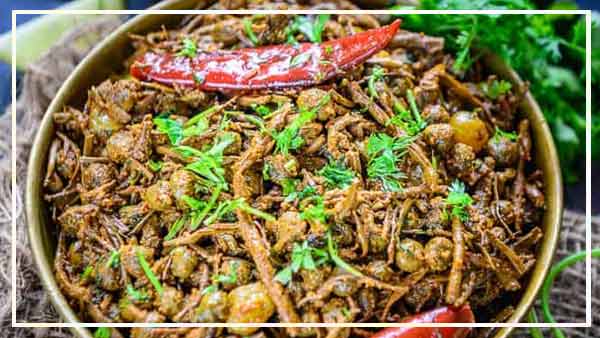
Ker Sangri is a sort of pickle that is a combination of Ker, which is a piquant wildberry, and Sangri are Khejri ‘s dried beans (the state tree of Rajasthan) – both are fried with a variety of local spices. This dish may not look particularly attractive, but it bursts with delightful flavors that make it a dish that must be tried. It can be savoured with bajra roti (millet or wheat flat bread).
3. Gatte ki Khichdi
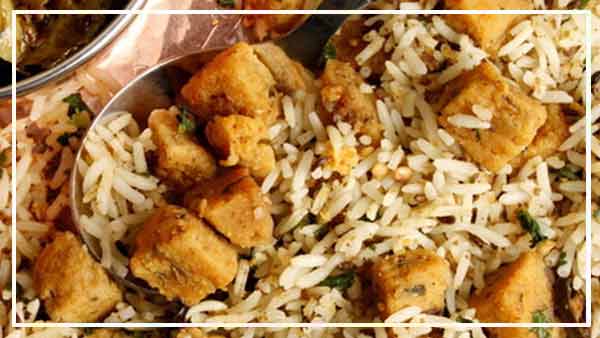
There is no doubt that Gatte ki Khichdi is the best rice preparation one can have in Rajasthan. This flavourful dish is the ideal evening snack, made with rice and soft besan dumplings. A favorite Rajasthan rice dish, known as Gatte ki Khichdi or Ram Paulo, is a rice dish attributed to the scarcity of green leafy vegetables in this desert region.
Gatte ki Khichdi is prepared with aromatic rice, spices, green peas, boiled / fried besan dumplings. These flavours blend into a mouth-watering, flavourful meal that is traditionally served with a chutney or curd on the side.
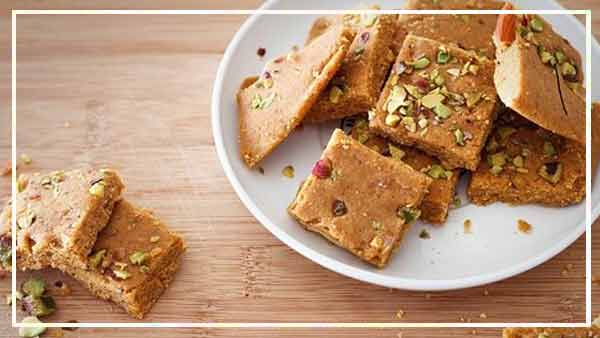
4. Dil Khushal
Rajasthan is known for its sweets which are toothsome. This mithai is popular as well as being Mohanthaal or Besan ki Barfi. It has a good chewy texture, and leaves your mouth with a grainy taste.
5. Boondo Raita
A very famous dish that every North Indian enjoys, it balances the taste of spices in your food and improves its flavour. Mixed with sweet and sour yogurt, the mild and salty boondo makes a mouthwatering mix.
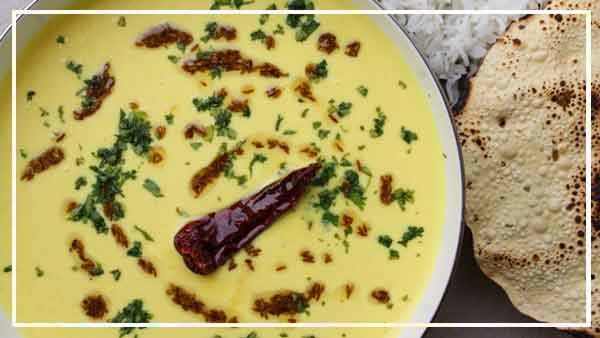
6. Rajasthani Kadi
We all had Maharashtra, Punjab and Uttarakhand kadis. The Rajasthani version is a pungent, spicy one that will give a kick start to your taste buds. This light and balanced dish is a staple diet in the state and accompanies rice very well.
7. Gatte ka Pulao
This rich combination of fresh steamed rice and spicy gatte, also known as Ram Pulao. Next boil the succulent hot gattas and then infuse them with spices to improve the pulao ‘s taste.
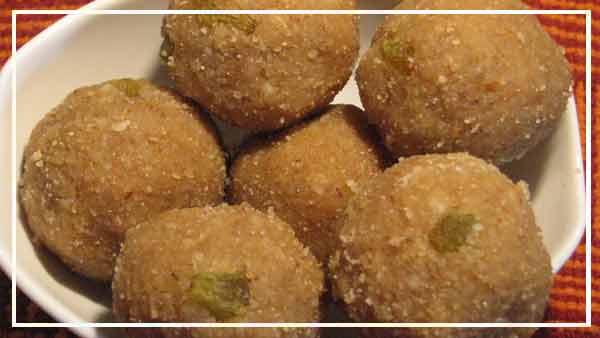
8. Churma Ladoo
Churma Ladoos, no Rajasthani feast is complete. The most delicious sweets you could have are those desi ghee ladoos served after dal bati. These delicious sideos with a mouthwatering are a must try.
9. Badam ka Halwa
Badam ka Halwa If there is a way to recreate memories of your childhood then it is this halwa. Hot piping halwa, especially during winters, is your best buddy. Prepared with dry fruits, suji, sugar and ghee, it melts as soon as you land on your tongue, making you go mmm …
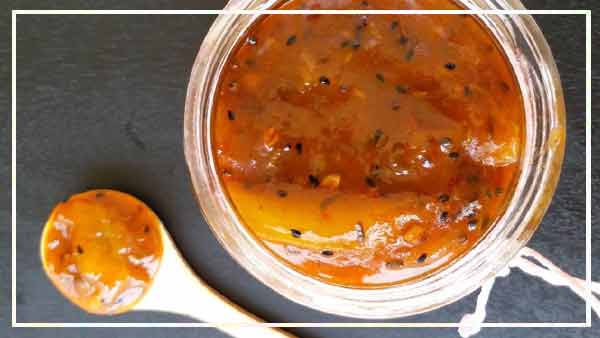
10. Aam ki Launji
An instant pickle made from raw mangoes, this is a heat beater for sure. It is prepared with sweet and sour gravy texture, with fennel and nigella. To enhance the flavor are added soft chunks of mango.
11. Methi Bajra Poori
This steaming hot Rajasthani snack is a health-conscious favourite. These finger leaching steamy pooris, prepared with minimum oil, taste delicious with chutney, aaloo and raita.
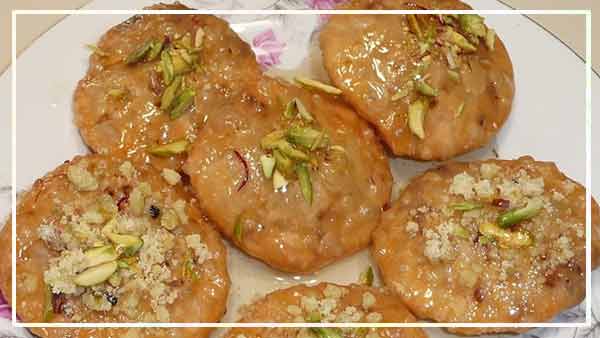
12. Mawa Kachori
Mawa Kachori, a variant of kachori, is filled with dry fruits and khoya, deep fried, and then sprinkled into sugar syrup. After lunch / dinner, one has to indulge in this dessert. If you say you don’t have a sweet tooth, then we’re saying you haven’t tried it yet.
13. Pyaaz Kachori
A variant of kachori, pyaaz kachori with a filling of onions, potatoes, and spices is prepared. This puffy pastry is a sell-out at any Rajasthan namkeen store. This breakfast snack is best enjoyed with tamarind chutney, sweet and sour.
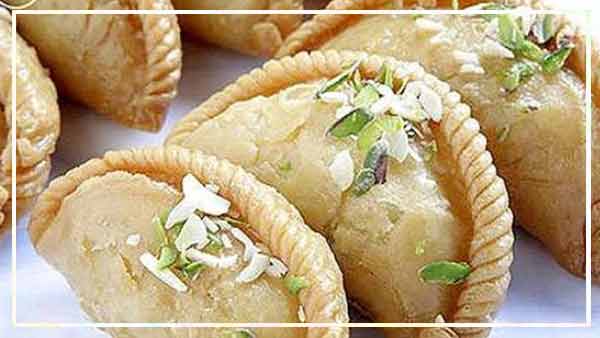
14. Gujia
Gujia Commonly known during Holi as a sweet savored, the majestic Gujia had to be from the royal state. The sugar syrup oozing from the khoya and dry fruit will immediately give you a much-needed sugar rush.
15. Shahi Gatte
Shahi Gatte, also known as the Govind Gatte, is a richer version of Masala Gatte, the popular dish. B esan dumplings are filled first with generous quantities of nuts and then deep fried. The rich , thick gravy tastes great with roti of any kind, as well as rice.
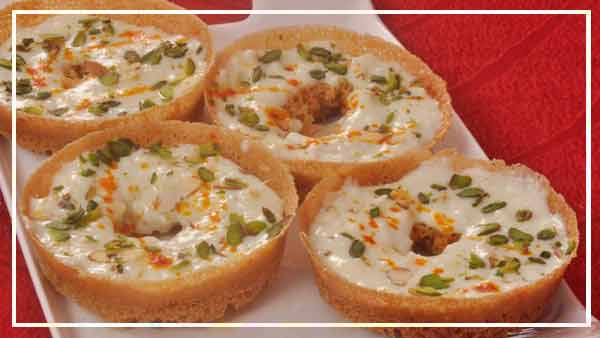
16. Ghevar
This sweet disc is prepared with ghee, flour, paneer, and sugar syrup. It comes in different varieties including Malai Ghevar, Mava Ghevar and Plain Ghevar. Without this delectable dish there is no Rajasthani ceremony complete.
17. Balushahi
Balushahi is a popular Rajasthani sweet dish, a dish that can comfortably handle the doughnut head on. A flaky texture on the outside and sugar syrup on the inside, every sweet lover swears by this one sweet dish.
18. Bajre ki Roti and Lashun ki chutney
Bajre ki roti made from bajra (millet) is a very popular and healthy flat bread which is enjoyed throughout Rajasthan. Although it can be taken with any vegetable dish or kadhi, it is usually savored with garlic onions and Lasun ki chutney. This combination remained a staple food for the local population.
Famous Destinations Cuisine of Rajasthan
Rajasthani cuisine, despite being a desert state, is a splendid array of colorful and unique dishes; the cuisine is very varied. Rajasthani cooking has been affected both by its inhabitants’ warlike lifestyles and by the lack of ingredient availability in such an arid area. Rajathan has a dry and hot climate and the most popular foods eaten include bajre ki roti, lahsun ki chutney with ointment and other pungent elements that add flavor to these simple meals. For the cuisine more ghee is used as ghee is considered to alleviate dryness. It is also known for its Bikaneri Bhujia, Mirchi Bada and Pyaaz ki Kachori snacks. Other popular dishes include Jodhpur’s Mawa Kachori, Jaipur’s Ghevar, Alwar ka mawa, Pushkar’s Malpuas and Bikaner’s Dry snacks, and the state-renowned Dall Bati-Churma. A distinctive characteristic of their cooking is the use of mango powder, a replacement for scarce desert tomatoes, and Asafoetida, to improve the taste in the absence of garlic and oignons. Rajasthani curries are brilliant red but not as spicy as they look due to the prevalence of red chilies, a staple in Rajasthani food since red chilies are heavily grown in the region, dried and packaged for sale. Marwari cuisine originating in the Marwar region is the speciality here. It is pure vegetarian and involves creative methods of cooking with ingredients such as gram flour to produce dishes that are like vegetable curries because there are few vegetables to give in the area. One example is the ‘Gatte ki Sabzi’ which is essentially dumplings of grams of flour. This cuisine is extensive even with the lack of fresh ingredients as seen in dishes such as Mirchi Bhajiya, Aloo ke Sooley or the Dal Samosa!
Udaipur :
Udaipur and his attempt with countless palaces , temples and havelis have drawn many to come and be part of the experience. Aptly dubbed by James Tod as the “most romantic place on India’s continent,” travelers from within and outside India visit Udaipur to experience history through culture and cuisine.
The “White City” was founded by Maharana Udai Singh II in 1559 and is the historic capital of the Mewar Kingdom. Owing to its well-connected lake network Udaipur is also known as the “Town of Lakes.” It is encircled by seven lakes, namely Lake Pichola, Lake Fateh Sagar, Lake Swaroop Sagar, Lake Rangsagar, Lake Doodh Talai, Lake Jaisamand and Lake Rajsamand. Besides the lakes, you can also visit the City Palace and Jag Mandir (built on Lake Pichola), both of which can be explored for leisure time. In reality, the City Palace houses a museum that has also very fascinating old paintings, utensils, and antique pieces.
Mewari is the local language (inspired by the Devanagari script) but also in Hindi and English most people converse. Udaipur cuisine has a range of vegetarian and non-vegetarian dishes which reflect the region’s royalty. A Mewari thali always includes dishes made with dry spices and dry fruits such as cashews, almonds, and raisins. The authentic thali is a must-see everywhere you go in Rajasthan. The intense and fiery flavors of game meats such as Khad Khargosh, Laal Maas and Safed Murg and Gatte ki Sabzi’s and Ker Sangri’s Marwari delights provide a delicious Rajasthani cooking experience.
You can join in with a local family for a special immersive culinary experience to get a sense of true Rajasthani hospitality and taste some beautiful homemade food in Udaipur.
Jodhpur :
What is most striking about Jodhpur is the blue hue that envelops the city. For many reasons, this blue color is accounted for as it has a cooling effect and is eye soothing. Another reason is associated with Lord Shiva where, since it was considered sacred, the Brahmin followers painted the town blue. Another explanation is that the walls Was painted with a mixture of mud, calcareous and copper sulphate where the copper sulphate gives it a rich shade of blue.
The Rajput clan is Marwar and Mewar, there are still traits which distinguish between the two regions. Marwar cuisine, which is what can be found locally in Jodhpur, is primarily vegetarian and the spread uses ingredients that reflect the state’s arid environment. A must-have, is the Jodhpuri Mirchi Bada. Rajasthan is famous for its chilies so when you visit Jodhpur, Stop selling these stuffed green chillies at a food stall, and just dig in. Mirchi Badas are available in all parts of Rajasthan but originally from Jodhpur.
You can join with a local family for a special immersive culinary experience to enjoy true Rajasthani hospitality and taste some amazing homemade food in Jodhpur
Pushkar :
If you wish to enjoy Rajasthan’s natural beauty, fly by car from Jaipur to Pushkar (or even Ajmer). The road is surrounded on either side by the Aravalli ranges and the scanty vegetation paints a captivating sight. Pushkar Lake is one of the most important tourist attractions. It holds mythological significance believed to be created by the tears of Lord Shiva while he mourned his beloved wife Shakti ‘s death. Some think the lake was also created when lotus petals fell from the hands of Lord Brahma on the floor.
Pushkar is Rajasthan’s one city which has more Western food to offer. Falafels to pita bread wraps and hummus, these dishes can satisfy your pangs of hunger as well as give you a break from all the local Rajasthani food.
Ajmer :
The attractions at Ajmer allow you to experience Rajasthan’s Indo-Islamic culture. On the one hand you can visit Jain temples like the gold-covered Soniji ki Nasiya and the wall carvings tell you a lot about Jain mythology. On the other hand, you can visit the world-famous Ajmer Sharif Dargah, built in honor of Garib Nawaz who advocated among the masses the concept of Sufism. Even the food contains a variety of typical Rajasthani dishes and Mughlai dishes such as Mutton Biryani and kebabs. Try the Kachori Kadhi and the Sohan Halwa for those who discover the city on foot and are looking to enjoy some street food.
Jaipur :
Rajasthan’s “Pink Area” gets its name because of the buildings’ dominant color. When, on their tour in 1856, the Prince of Wales and Queen Victoria visited India, Maharaja Ram Singh decided to wash the city in pink as the color means hospitality. Jaipur is also part of the ‘Golden Triangle’ of India (tourist circuit consisting of Delhi , Agra, and Jaipur). Two UNESCO World Heritage Sites-Jantar Mantar and Amer Fort-are also in the town. Besides these two, travelers also tend to visit the Hawa Mahal, there are many local markets where artisans and craftsmen can be found promoting the heritage through their art. You can purchase some of the things like dupattas bandhani, mojiris, miniature paintings, leather ware, etc.
In Jaipur you have to indulge your sweet tooth when it comes to food. It is renowned to a large extent for its variety of sweets like Mohan Thal, Ghevar, Mawa Kachori, Gajak and more.
You can join in with a local family for a special immersive culinary experience to get a sense of real Rajasthani hospitality and taste some beautiful homemade food in Jaipur.
Bikaner :
Another city of Rajasthan and a new bunch of palaces and forts to discover. If you are visiting Bikaner sometime in January, make sure to attend the camel festival. There are some fun activities to enjoy including camels dressed in colourful attire. Now if you are in Rajasthan, going on a camel safari in the Thar desert is a must. The rocking movement back and forth is putting a strain on your backbone but the one-time experience is worth it! Even, if the rats don’t scare you or squeamish you, pay a visit to the Karni Mata temple that houses nearly 25,000 rats. The temple is regarded as very sacred, and is often packed with tourists.
The town is renowned for its bhujia, spicy papad, and variety of namkeen (salty / savoury snacks). Bikaner’s local food was influenced by warlike lifestyles. Food and food were scarce so dishes must be filled with whatever was available and could last a stretch for days. Butter and buttermilk are also used in food made from Bikaneri. Dishes such as Ker Sangri, Khichdi, Gatte ki Sabzi and Mangodi are also made in other parts of Rajasthan but each has a different way to prepare it.
Jaisalmer :
Jaisalmer, the “Golden City” gets its name from the yellow sand and yellow sandstone used in every building which gives it a yellow-golden tint. Jaisalmer is a World Heritage Site featuring the Jaisalmer Fort as its crown.
Unlike Bikaner, where butter and buttermilk are used in most dishes, Jaisalmer ‘s diet largely avoids butter and oil. Ker Sangri is a dish made commonly in the city. Besides that, Murg-e-Subz (cut boneless pieces of chicken cooked with vegetables) is a favorite crowd.
Most restaurants give you a fairly good picture of what Rajasthani food is like. But if you want the full local experience you can always opt to dine with a local Rajasthan family. Not only can you encounter with an Indian family a home-cooked meal, you will also learn more about Rajasthan and its rich and well-preserved cultural heritage. Check it out here – Jaipur, Jodhpur and Udaipur.

